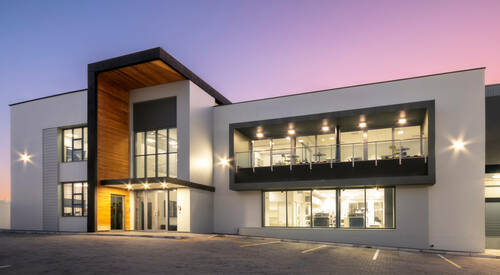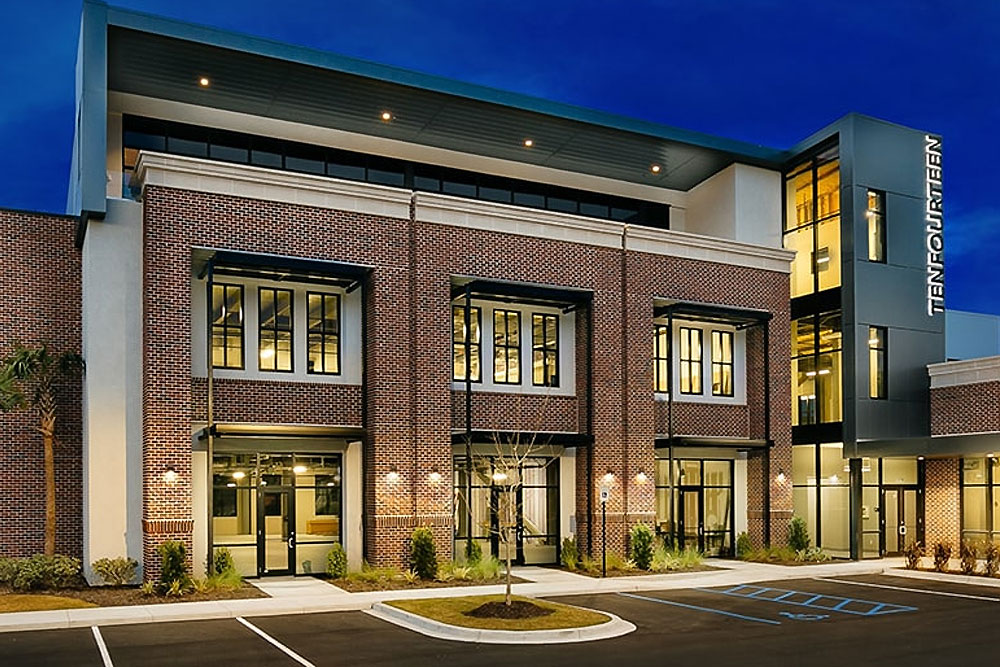Why commercial architects Embed Eco-Conscious Strategies in Today’s Commercial Builds
How Commercial Architects Can Transform Your Organization Room With Professional Style Providers
Commercial architects play an essential duty in reshaping service settings. Their knowledge in style can considerably improve both performance and aesthetics. By creating spaces that show a brand's identity, they enhance operational effectiveness and staff member fulfillment. However, the effect of their job extends past plain appearance. Comprehending the subtleties of cooperation and sustainability can result in transformative results. What particular components make these changes effective?
Comprehending the Duty of Commercial Architects
Commercial architects play a necessary role fit service environments that are both functional and visually pleasing. They concentrate on designing rooms customized to the certain demands of services, making sure that every square foot is utilized efficiently. These professionals integrate components such as spatial design, lights, and materials to improve productivity and worker wellness. By teaming up with customers, industrial architects collect understandings into functional requirements and brand name identification, translating these right into cutting-edge designs.Additionally, they browse complicated building regulations and zoning laws, making certain compliance while taking full advantage of style possibility. Their competence prolongs to sustainability methods, promoting energy performance and eco-friendly materials in their tasks. Through their imaginative vision and technological understanding, business architects not just develop enticing spaces yet likewise foster atmospheres that promote cooperation and growth. Inevitably, their payments substantially influence the general success and picture of a company.
Benefits of Professional Layout Providers

Customizing Areas to Your Brand Identification
Customizing rooms to a brand's identification is necessary for communicating its core values and mission. Commercial architects play a critical duty in improving a company's aesthetic identification via thoughtful design choices. By aligning architectural aspects with brand principles, firms can produce atmospheres that reverberate with customers and employees alike.
Showing Brand Values
Exactly how can a properly designed area symbolize a company's core values? Commercial architects play a critical role in shaping atmospheres that reverberate with a brand name's identity. By incorporating elements such as color design, products, and designs, they develop rooms that show the significance of business. A technology firm might choose for open formats and contemporary home furnishings to communicate technology and partnership, while a luxury brand name might choose stylish finishes and intimate spaces to evoke exclusivity and sophistication. Thoughtful style not just boosts performance yet likewise cultivates a strong link in between employees, customers, and the brand. Inevitably, a well-crafted atmosphere functions as a tangible depiction of a company's objective and vision, reinforcing its worths at every touchpoint.
Enhancing Visual Identification
What aspects can efficiently elevate a brand's visual identification within a business room? Commercial architects play an essential role in incorporating design features that resonate with a business's principles. Color pattern, typography, and products can be strategically selected to mirror brand worths while guaranteeing visual charm. Furthermore, including logos and brand name images into the style can create a cohesive aesthetic story. Lighting design can even more enhance the atmosphere, guiding customer perceptions and experiences (commercial architects). Format and furnishings options must line up with the brand's individuality, whether it's contemporary, standard, or ingenious. Ultimately, a properly designed business space not only brings in clients but also enhances brand name acknowledgment, creating a lasting impact that promotes commitment and interaction
Enhancing Capability and Performance
Enhancing performance and efficiency in business areas entails maximizing other room utilization and making workflows that streamline operations. Architects focus on producing layouts that lessen squandered area while assisting in smooth modifications in between jobs. This technique not only enhances efficiency but likewise contributes to an extra cohesive workplace.
Maximizing Space Utilization
Effective area utilization is a crucial aspect in industrial style, where the design must balance appearances with performance (commercial architects). Architects utilize numerous techniques to optimize offered square footage while making sure that each area serves an unique purpose. By evaluating workflow, website traffic patterns, and customer needs, architects can create designs that boost both employee efficiency and customer experience. Multi-functional spaces, adaptable furnishings setups, and optimized storage space services are crucial parts in accomplishing this goal. Furthermore, incorporating all-natural light and open areas fosters a much more inviting ambience, more boosting the energy of the setting. Inevitably, effective area use not only enhances operational efficiency however additionally contributes favorably to the total brand picture, making it a necessary factor to consider in industrial design
Streamlined Operations Style
Exactly how can a well-designed process transform a business room right into a hub of productivity? Streamlined process layout concentrates on maximizing the physical format and operational procedures within a company setting. By strategically preparing over here workstations, conference locations, and resources, architects can remove unneeded motion and enhance partnership. This thoughtful style reduces diversions and assists in interaction, permitting workers to focus on their jobs much more efficiently. On top of that, incorporating modern technology right into the workflow can even more automate procedures, reducing time spent on regular tasks. Therefore, organizations experience enhanced worker spirits and enhanced result, developing a vibrant ambience that cultivates innovation. Ultimately, purchasing structured process design not only boosts capability but likewise places a business space for sustainable development and success.
Promoting Partnership Via Design
Although contemporary work spaces usually focus on individual performance, the layout of commercial rooms increasingly highlights cooperation as a key motorist of innovation and group communication. Architects play an essential function in creating settings that promote communication amongst staff members. Open up layouts, multifunctional spaces, and strategically positioned public locations encourage spontaneous discussions and brainstorming sessions.Incorporating elements such as movable furniture and adaptable meeting areas allows teams to reconfigure areas based on their collective needs. Furthermore, integrating innovation, like interactive white boards and video conferencing tools, improves the capability to communicate efficiently, no matter location.Natural light and biophilic design elements also contribute to a much more inviting environment, advertising comfort and health, which are essential for effective team effort. By concentrating on these elements, commercial architects can develop vibrant environments that not just boost partnership but also drive overall company success.
Lasting Design Practices in Commercial Architecture

Case Researches: Successful Improvements by Commercial Architects
The implementation of lasting style practices has not just improved the method to commercial design yet has additionally caused impressive transformations in different service areas. One remarkable situation is the redesign of a tech firm's headquarters, where architects integrated all-natural light and green wall surfaces, leading to enhanced worker health and efficiency. This makeover reduced energy costs by 30% and boosted the business's public image.In an additional circumstances, a retailer went through a full overhaul, utilizing recovered materials and energy-efficient systems. This not only attracted eco-conscious consumers however likewise increased foot web traffic by 25%. A 3rd case involved a business office that embraced an open-plan layout with adaptable offices, cultivating collaboration amongst teams. The architects' concentrate on creating a vivid and versatile atmosphere significantly increased employee fulfillment. These study exhibit exactly how commercial architects can create impactful areas that line up with service goals and sustainability efforts.
Frequently Asked Concerns
Just How Much Do Commercial Style Solutions Commonly Expense?
The price of commercial architecture services varies widely, typically varying from $100 to $250 per hour. Elements influencing rates consist of task intricacy, place, and the architect's experience, making it important for organizations to acquire detailed price quotes.
What Sorts Of Organizations Benefit The Majority Of From Commercial Architects?
Different businesses, including retail, friendliness, and company offices, greatly gain from business architects. These experts boost functionality, aesthetics, and brand identification, ensuring areas are optimized for customer interaction and staff member productivity, eventually cultivating business growth.
Exactly how Lengthy Does a Commercial Style Project Typically Take?
The timeline for a business design project usually varies from several weeks to a number of months. Variables affecting duration include job intricacy, governing authorizations, and collaboration amongst stakeholders, every one of which can impact overall completion time.
Can I Employ an Industrial Designer for Improvements Just?
Yes, working with a business designer for restorations is viable. Several architects concentrate on renovation projects, offering experience in maximizing existing spaces while sticking to guidelines and improving capability, aesthetic appeals, and general worth of the service atmosphere.
What Certifications Should I Try to find in an Industrial Designer?
